The usage of mobile phones in current scenarios is in increasing rate. Common people use mobile phones such as iphones, Smart phones, Apple iPad, etc to access internet services. Today‟s the emerging growth in mobile applications along with cloud computing concepts; Mobile Cloud Computing (MCC) has been introduced as a potential technology for mobile services. MCC is an integration of cloud computing in the mobile environment, which improves the overall performance of the mobile devices such as battery life, storage, etc. MCC still faces a number of challenges in both mobile and computing side, one of which is providing Quality-of-Service (QoS), which means how a service provider can ensure QoS of its cloud services. The provision of QoS in mobile cloud computing is a challenging task. This is because of the dynamic characteristic of mobile networks and limited resources of mobile devices such as bandwidth, delay, packet loss ratio, battery life, storage capacity, computational power, security, etc. To overcome this problem, Mobility Aware QoS Framework for Mobile Cloud Computing (MAQFMCC) and Mobility Aware QoS Analysis Algorithm (MAQAA) are implemented in addition to this an Artificial Neural Network is used for modelling the framework.
Keywords |
| QoS, Mobile Cloud Computing, quality service, mobile services. |
INTRODUCTION |
| Now-a-days, mobile devices such as cell phones, Smart phones, Tablet PCs, etc are rapidly becoming an important
part of human life as the most effective and convenient communication tools, which are not restricted by time and
place. Mobile users get various services from mobile applications (e.g., iphone apps, Google apps, Android apps etc.)
which run on the devices. After the invention of Mobile Cloud Computing (MCC), the mobile devices from remote
servers (cloud servers) via wireless networks can access these applications. The rapid progress of mobile computing
(MC) [1] becomes a powerful trend in the development of IT technology as well as commerce and industrial fields.
However, the mobile devices are facing many challenges in their resources (e.g.: battery life, storage and bandwidth)
and communications (e.g.: mobility and security) [2]. The limited resource significantly reduces quality of the services.
Mobile Cloud Computing faces a number of challenges both at mobile side and computing side, one of which is
Quality-of-Service (QoS) i.e., how a service provider can ensure QoS for its cloud services. |
| Mobile Cloud Computing (MCC) has been recognized as the next generations computing infrastructure where both
the data storage and the data processing happen outside of the mobile device. Mobile cloud applications move the
computing power and data storage away from mobile phones and into the cloud. Cloud Services can be accessed
through mobile devices such as smart phones, iphones, etc. It brings new types of services and facilities for mobile
users to take full advantages of cloud computing. |
| This paper presents a Mobility Aware QoS Framework for Mobile Cloud Computing (MAQMCC) and Mobility
Aware QoS Analysis Algorithm (MAQAA). Section II discusses the related work. Section III explains mobility aware
QoS analysis algorithm for MCC. Numerical and simulation results are presented in section IV. Conclusion is
presented in Section V. |
RELATED WORK |
| The research work on cloud computing falls in various aspects such as cloud computing architecture, cloud services,
cloud security, cloud service and research management. Peng et al [3] proposed on QoS aware system for mobile cloud
services. The system provides a QoS framework to monitor the status of QoS in each mobile cloud service terminal.
The system also considers other factors influences on different cloud service modes with regard to QoS, e.g.,
availability, stability, etc. |
| Some of existing work focuses on QoS aware web service. Lodi et al [4] proposed a middle-ware architecture for
enabling service level agreement (SLA)- driven clustering of QoS- aware application servers. Some work focus on QoS
architecture design for cloud computing, Wang et al [5] proposed on adaptive QoS management framework for VOD
(Video on Demand) cloud service centres. Ye et al [6] proposed a framework for QoS and power management in a
service cloud environment with mobile devices. Some work focus on mechanisms for QoS management in cloud
computing. Li [7] proposed on adaptive management of virtualized resources in cloud computing using feedback
control. Xiao [8] proposed a reputation based QoS provisioning in cloud computing via Dirichlet multinomial model. |
| The existing work comprehensively and flexibly supports using both QoS properties and QoS service modes as key
parameters for run time QoS adaptive assurance. Yan [9] proposed an adaptive trust control model to evaluate,
establish, specify and ensure the trust relationships among system entities. All the existing work only concentrate on
static mobile cloud computing framework, where all the nodes considers as static nodes. |
MOBILITY AWARE QOS ANALYSIS ALGORITHM |
| In this section the system architecture of the framework, its modelling and the proposed algorithm has been
discussed in detail. |
| System Architecture: |
| Fig.1 shows a Mobility Aware QoS Framework Architecture. The system architecture consists of three layers, The
Mobile Phones (Clients), QoS Manager and Cloud Service Provider. In a mobile device, a QoS agent monitors the
status of the mobile device at running time, such as, the transmission rate, percentage of memory and power
consumption, packet loss ratio, etc. The QoS status will report to QoS manager in cloud side. The QoS manager calculates the QoS requirement of the client and analyses the requirement against the cloud service modes running on
cloud side using Mobility Aware QoS Analysis Algorithm. It also thoroughly monitors the mobility of each service
modes and coverage of client with each cloud service provider using mobility checker. As per the client‟s requirements,
the QoS manager dynamically adjusts the resources to meet QoS requirements of each cloud services. |
| B. Framework Modeling: |
| An Artificial Neural Network (ANN) has been used to modelling the framework. The ANN model includes three
layers of nodes such as input layer, hidden layer and output layer. The input layer consists of set of cloud service modes
(SMj). The hidden layer represents the training algorithm. We have proposed a training algorithm called Mobility
Aware QoS Analysis Algorithm (MAQAA) to analyses and select quality service mode according to the client‟s
requirement. The output layer represents QoS value of each service modes (SMj). Fig.2 shows the framework
modelling based on ANN. |
| C. Mobility Aware QoS Analysis Algorithm (MAQAA): |
| Aim of the proposed algorithm is to analyse the cloud service modes (SMj) provided by various cloud service
providers based of various QoS parameters and select the QoS guaranteed service modes for delivering services to its
clients. The algorithm uses seven QoS parameters such as transmission rate, packet loss ratio, cost, bandwidth,
reliability, availability and mobility to analyze the client‟s requirement for providing quality service. The varies QoS
parameters are discussed below. |
| Mobility Aware QoS Analysis Algorithm calculates QoS value [μ (SMj)] for each cloud service modes (SMj) based
on the seven QoS parameter. For calculating the QoS value, the algorithm defines quality vector for service mode SMj
that is defined as, |
 |
| The MAQAA uses fuzzy multi-attribute approach [10][11] for selecting QoS guaranteed service mode SMj.
Mobility Aware QoS Analysis Algorithm is presented below, |
MAQAA Algorithm |
| Step 1: Obtain the QoS parameters such as transmission rate qTR, Packet Loss Ration qPLR, Bandwidth qBW, Cost qcost,
Reliability qreliability, and Availability qavail for all service modes SMj. |
| Step 2: Detect the fading effect of signal strength and hand off of the mobile device to measure the mobility of the each
service modes SMj. |
| Step 3: Calculate the distance between client and each service modes SMj based on the mobility. |
| Step 4: Construct a quality vector q(SMj) using the values obtained from step 1-3 for each QoS parameters for each
service modes SMj. |
| q(SMj) = { qTR(SMj), qPLR(SMj), qBW (SMj), qCost(SMj), qreliability(SMj), qavail(SMj), qmobility(SMj) } |
| Step 5: Construct a quality matrix Q using the service modes SMj. |
 |
| Step 6: Scale the quality matrix to make the QoS parameter value in an common representation using the formula |
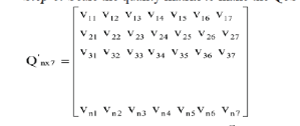 |
 |
| For negative QoS parameters such as cost, packet loss ratio, mobility. |
 |
| For positive QoS parameters bandwidth, transmission rate. |
| Step 7: Compute the quality vector value using quality matrix for the positive (g) and negative(b) QoS parameters of
each service modes SMj. Quality vector of the positive QoS parameters denoted by „g(SMj)‟ in Qn×7 is defined as |
| g(SMj) = { g1(SM1), g2(SM2), g3(SM3), g4(SM4), g5(SM5), g6(SM6), g7(SM7), g8(SM8)}
= { Max(vi1), Max(vi2), Max(vi3), Max(vi4), Max(vi5), Max(vi6), Max(vi7), Max(vi8) } |
| Quality vector for the negative QoS parameters denoted by „b(SMj)‟ in Qn×7 is defined as, |
| b(SMj) = { b1(SM1), b2(SM2), b3(SM3), b4(SM4), b5(SM5), b6(SM6), b7(SM7), b8(SM8)}
= { Min(vi1), Min(vi2), Min(vi3), Min(vi4), Min(vi5), Min(vi6), Min(vi7), Min(vi8) } |
| Step 8: Compute the weighted Euclidean distance for both positive and negative QoS parameters of each service modes
SMj using the formula, Weighted Euclidean distance between service modes (SMj) and the negative QoS parameters
„b(SMj)‟ is defined as dneg(SMj). |
 |
| Weighted Euclidean distance between service modes (SMj) and the positive QoS parameter is defined as dpos(SMj). |
 |
| Step 9: Calculate the QoS value of each service modes SMj. using the formula, The QoS value of service mode denoted
by μ(vi) is defined as, |
 |
| Where, n is the number of service modes (SMj),
7
j 1
j w and wj represents the weight of the jth quality criterion |
| Step 10: Choose the service modes SMj as the QoS guaranteed service mode which has maximum QoS value. |
 |
RESULT ANALYSIS |
| In this section we discussed the numerical and simulation result analysis of the proposed algorithm. |
| A. Numerical Results: |
| We tested the proposed algorithm with 8 service modes and 7 QoS parameters such as Transmission Rate (TR),
Packet Loss Ratio (PLR), Bandwidth (BW), Cost, Reliability, Availability and Mobility. We take the data in Table 1 as
an example to illustrate the algorithm numerically in detail. |
| The proposed algorithm MAQAA has mathematically worked out with the sample data given in Table 1. In this
example the unit of QoS parameters for all service modes is same. The weighted vector used in this example is
w = (0.3, 0.1, 0.1, 0.1, 0.1, 0.1, 0.2). The quality vector Q has constructed using Table 1. Using Step 6 of the algorithm
stated in section III, the quality vector has scaled for a common representation which simplifies the mathematical
process. The scaled quality matrix has given in Fig.3. |
| According to the definitions of positive and negative QoS parameters discussed in the algorithm, quality vector g
and b are calculated and the values are obtained given below. |
| g(SMj) = { 0.56,0.5,0.51,0.89,0.63,0.83,0.51,0.78} |
| b(SMj) = { 0.25,0.11,0.38,0.53,0.33,0.22,0.17,0.2} |
| According to the definition of μ(SMj) the QoS value for each service modes are calculated. For our example the QoS
values are, |
| μ(SMj) = { 0.48, 0.47,0.56,0.77,0.17,0.38,0.73,0.75}. |
| Based on the proposed algorithm the service mode which has maximum QoS value is selected as a QoS guaranteed
service modes. So the mobility aware QoS framework selects the service mode SM4 as QoS guaranteed service mode
and let the service mode SM4 to deliver the services to the clients. |
| B. Simulation Results: |
| We simulated our proposed algorithm MAQAA using NS2 simulator with an arbitrary wireless topology having 20
nodes and 40 edges. The purpose of simulation is to compare the performance of our algorithm against the other service
mode selection approaches such as Random Approach (RA) and No-MCC. The following graphs illustrate the
performance analysis of the proposed algorithm MAQAA and other approaches. |
| Fig.4 describes the comparison of MAQAA algorithm with other approaches such as no-MCC and Random based on
No.of Hand offs and Availability of Service Modes. Fig.4 shows that the MAQAA algorithm has higher rate of
availability of service modes than other approaches even the number of mobile hand offs increases. Next the MAQAA
has compared with No-MCC and Random Approach based on Service Utilization percentage. It is illustrated in Fig.5. |
| Fig.5 shows that the service utilization level of the MAQAA algorithm is better than other two approaches, since
MAQAA algorithm consider the mobility and other QoS parameters of each service modes and choose the QoS
guaranteed service mode. So the cloud service accessed by clients can be highly reliable and its leads higher utilization
of service that other approaches. |
CONCLUSION AND FUTURE WORK |
| This paper has proposed a Mobility Aware QoS Framework for mobile Cloud Computing and proposed a Mobility
Aware QoS Analysis Algorithm. This algorithm analysed the QoS guaranteed service modes out of „n‟ number of
services modes provided by various cloud service providers and allow the selected provider to provide cloud services to
its clients. The framework used seven QoS parameters for analysing the service modes including mobility. This way
the proposed algorithm leads the other algorithm by considering the mobility factor of each service modes and choose
the QoS guaranteed services modes. The results show that the proposed algorithm increases the availability and
utilization of cloud services compare to other similar service selection approaches. |
Tables at a glance |
 |
| Table 1 |
|
| |
Figures at a glance |
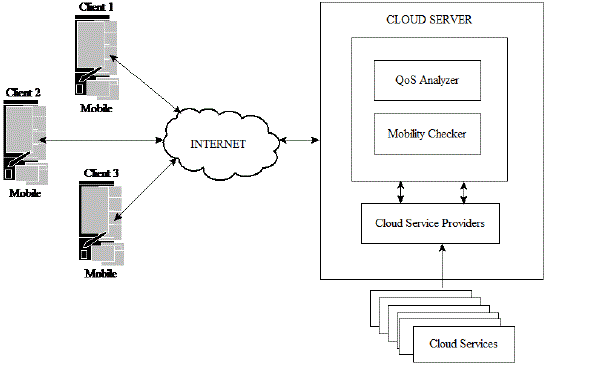 |
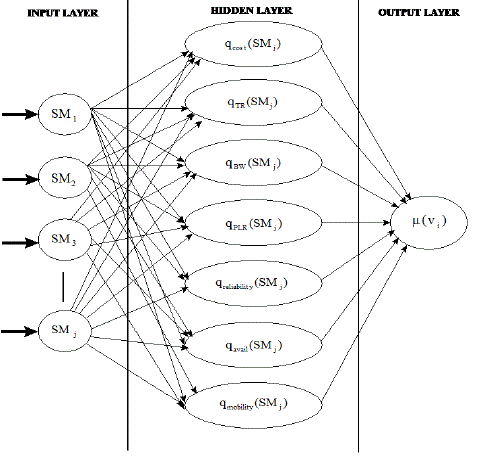 |
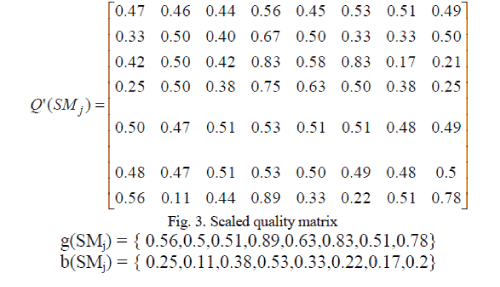 |
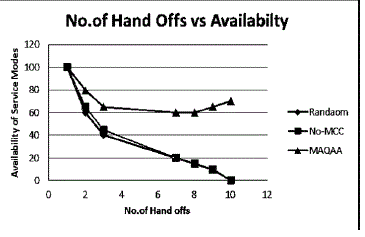 |
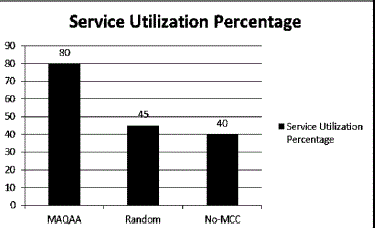 |
| Figure 1 |
Figure 2 |
Figure 3 |
Figure 4 |
Figure 5 |
|
| |
References |
- M. Armbrust, âÃâ¬ÃÅAbove the Clouds: A Berkeley View of CloudâÃâ¬ÃÂ, University of California, Berkeley, February 2009.
- S. Perez. Why Cloud Computing is the Future of Mobile, âÃâ¬ÃÅhttp://www.readwriteweb.com/archi ves/why_cloud_computing_is_the_future_of mobile.phpâÃâ¬ÃÂ, August 2009.
- Peng Zhang and Zheng Yan, "A QoS-aware system for mobile cloud computing", IEEE International Conference on Cloud Computing and Intelligence Systems (CCIS), Pp: 518 - 522, Sept 2011.
- G. Lodi, F. Panzieri, D. Rossi, E. Turrini, âÃâ¬ÃÅSLA-Driven Clustering of QoS-Aware Application ServersâÃâ¬ÃÂ, IEEE Transactions on Software Engineering, VOL. 33, NO. 3, pp. 186-197, March 2007.
- X. Wang, Z. Du, X. Liu, H. Xie, X. Jia, âÃâ¬ÃÅAn adaptive QoS management framework for VoD cloud service centers. 2010âÃâ¬ÃÂ, International Conference on Computer Application and System Modeling (ICCASM), Volume: 1, pp. 527-532, 2010.
- Y. Ye, N. Jain, L. Xia, S. Joshi, I-L. Yen, F. Bastani, K. L. Cureton, M. K. Bowler, âÃâ¬ÃÅA Framework for QoS and Power Management in a Service Cloud Environment with Mobile DevicesâÃâ¬Ã Fifth IEEE International Symposium on Service Oriented System Engineering (SOSE), pp. 236 âÃâ¬Ãâ 243, 2010.
- Q. Li, Q. Hao, L. Xiao, Z. Li, âÃâ¬ÃÅAdaptive Management of Virtualized Resources in Cloud Computing Using Feedback ControlâÃâ¬ÃÂ, 1st
- Y. Xiao, C. Lin, Y. Jiang, X Chu, X. Shen, âÃâ¬ÃÅReputation-Based QoS Provisioning in Cloud Computing via Dirichlet Multinomial ModelâÃâ¬ÃÂ, IEEE International Conference on Communications (ICC), pp. 1 - 5, 2010.
- Z. Yan, C. Prehofer, âÃâ¬ÃÅAutonomic Trust Management for a Component Based Software SystemâÃâ¬ÃÂ, IEEE Transactions on Dependable and Secure Computing, doi. 10.1109/TDSC.2010.47, pp. 810 - 823, September 2010.
- Chen S J, âÃâ¬ÃÅFuzzy multiple attribute decision making: methods and applicationsâÃâ¬ÃÂ, Berlin: Springer-Verlag, ISBN: 978-3-540-54998-7, vol.375, Pages 289-486, 1992.
- Chen Shouyu, âÃâ¬ÃÅTheory of fuzzy selection for multistage and multi objective decision making system", The Journal of Fuzzy mathematics,volume 2, pp. 163-174. 1994.
|